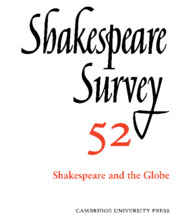Book contents
- Frontmatter
- Reconstructions of the Globe: A Retrospective
- ‘Useful in the Year 1999’: William Poel and Shakespeare’s ‘Build of Stage’
- Reconstructing the Globe: Constructing Ourselves
- From Liturgy to the Globe: the Changing Concept of Space
- The Arithmetic of Memory: Shakespeare’s Theatre and the National Past
- Maximal and Minimal Texts: Shakespeare v. the Globe
- William Shakespeare’s Romeo + Juliet: Everything’s Nice in America?
- Which is the Jew that Shakespeare Knew?: Shylock on the Elizabethan Stage
- A Little Touch of Harry in the Light: Henry V at the New Globe
- Gulls, Cony-Catchers and Cozeners: Twelfth Night and the Elizabethan Underworld
- The Globe, the Court and Measure for Measure
- Macbeth and the Antic Round
- Macbeth / Umabatha: Global Shakespeare in a Post-Colonial Market
- When All is True: Law, History and Problems of Knowledge in Henry VIII
- ‘All which it inherit’: Shakespeare, Globes and Global Media
- ‘Delicious traffick’: Alterity and Exchange on Early Modern Stages
- The 1998 Globe Season
- Shakespeare Performances in England, 1998
- Professional Shakespeare Productions in the British Isles January-December 1997
- The Year's Contributions to Shakespeare Studies 1 Critical Studies
- 2 Shakespeare’s Life, Times, and Stage
- 3 Editions and Textual Studies
- Books Received
- Index
When All is True: Law, History and Problems of Knowledge in Henry VIII
Published online by Cambridge University Press: 28 March 2007
- Frontmatter
- Reconstructions of the Globe: A Retrospective
- ‘Useful in the Year 1999’: William Poel and Shakespeare’s ‘Build of Stage’
- Reconstructing the Globe: Constructing Ourselves
- From Liturgy to the Globe: the Changing Concept of Space
- The Arithmetic of Memory: Shakespeare’s Theatre and the National Past
- Maximal and Minimal Texts: Shakespeare v. the Globe
- William Shakespeare’s Romeo + Juliet: Everything’s Nice in America?
- Which is the Jew that Shakespeare Knew?: Shylock on the Elizabethan Stage
- A Little Touch of Harry in the Light: Henry V at the New Globe
- Gulls, Cony-Catchers and Cozeners: Twelfth Night and the Elizabethan Underworld
- The Globe, the Court and Measure for Measure
- Macbeth and the Antic Round
- Macbeth / Umabatha: Global Shakespeare in a Post-Colonial Market
- When All is True: Law, History and Problems of Knowledge in Henry VIII
- ‘All which it inherit’: Shakespeare, Globes and Global Media
- ‘Delicious traffick’: Alterity and Exchange on Early Modern Stages
- The 1998 Globe Season
- Shakespeare Performances in England, 1998
- Professional Shakespeare Productions in the British Isles January-December 1997
- The Year's Contributions to Shakespeare Studies 1 Critical Studies
- 2 Shakespeare’s Life, Times, and Stage
- 3 Editions and Textual Studies
- Books Received
- Index
Summary
In the last scene of The Famous History of the Life of King Henry the Eight. Cranmer’s prophecy provides Elizabeth’s father with knowledge of the future not available at the play’s ostensible chronological cut-off point in 1533;; nor, because of the legal arrangements Henry left, was this future imaginable when Henry died in 1547. The panegyric delivered from the perspective of 1613 is a utopian evaluation of the Elizabethan past and the Jacobean present which the stage Henry receives as an ‘oracle of comfort’ (5.4.66), and the obvious flattery requires Cranmer’s prefatory affirmation that the words he utters are all ‘truth’ (15–16); less obvious in this context of apparently uncomplicated praise is that the prophecy builds on a series of real historical ironies and legal reversals that represented major defeats for Henry and his plans for the future. Henry learns here that Elizabeth will reign, but that she will die childless (thus extinguishing the direct line of succession with which he was obsessed); the second major piece of information Cranmer provides is buffered by linguistic evasions that neatly sidestep the problem of revealing the name of Elizabeth’s Stuart successor and the ultimate triumph of the Scottish line that Henry had passed over when he laid out his dispositions for succession in his last will and testament.
- Type
- Chapter
- Information
- Shakespeare Survey , pp. 166 - 182Publisher: Cambridge University PressPrint publication year: 1999
- 1
- Cited by

